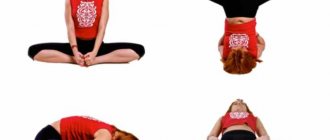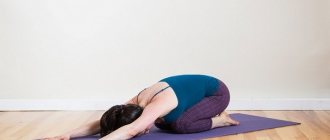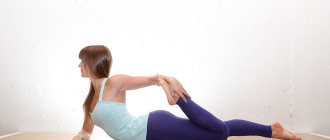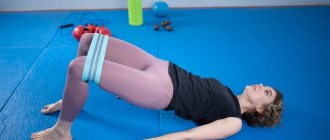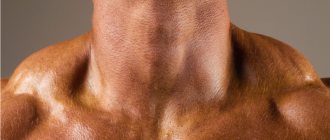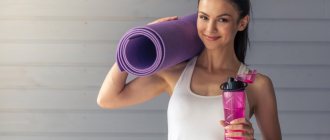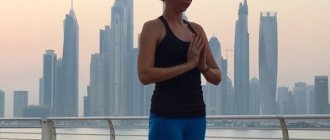From the words “urdhva” - upward, and “dhanu” - bow for shooting. In this pose, the body bends backward, supporting itself on the palms and soles. When performing this position, the body is like a bow facing upward, which is why the asana is called Urdhva Dhanurasana.
Bridge pose in yoga is called Urdhva Dhanurasana in Sanskrit. Urdhva is translated as vertical, Dhanura - bow, asana - asana. The photo of this pose is published by Shri B.K.S. Iyengar in his book “Yoga Deepika. Clarification of Yoga." This is a complex backbend. In order not to harm the spine and nervous system, it is recommended to learn this pose after mastering standing poses and simple backbends under the guidance of a qualified teacher. The feet and palms on the floor evenly bear the weight of the body, like the four legs of a bridge. The feet are moved as close to the pelvis as possible, the outer edges of the feet are pelvis-width apart and parallel to each other. Legs are bent at the knees. Palms are shoulder-width apart, fingers are spread wide apart and turned towards the feet. Arms straight. The legs, torso, arms and head make a smooth, uniform arc. The gaze is directed either parallel to the floor or down perpendicular to the floor, strictly in the center. The mastery of performing a pose lies in the ability to make a uniform bend with the entire spine, making maximum use of the legs and arms, without straining the brain and nervous system.
Execution technique
Lie on your back. If necessary, place a folded blanket under your shoulders to protect your neck.
Bend your knees and place your feet on the floor so that your heels are as close to your sit bones as possible. Hands lie along the body, on the floor.
As you exhale, pressing your palms and feet into the floor, lift your tailbone up, moving it towards the pubic bone. As you do this, tighten your gluteal muscles, also lifting your buttocks and hips off the floor. Hips and feet should be parallel to each other.
Place your hands together on the floor, under your hip bones, and stretch your torso through your arms, arching it, and use your arms to support your torso on your shoulders.
Try to raise your thighs so high that they are parallel to the floor. Your knees should be directly above your heels (as you perform the pose, you try to push your hips up from your heels). At the same time, pull the tailbone towards the knees, and lift the pubic bone and point it towards the navel.
Raise your chin slightly, moving it away from the sternum, and pressing your shoulder blades towards your back, bring and press the jugular cavity to the chin.
Tighten your triceps, widen your shoulder blades, and try to lift the space between them—from the base of your neck—up your torso. The meaning of this description refers to the direction of movement of the upper spine.
This is
the final position .
Stay there for about 30-60 seconds, breathing normally. Exiting the pose: exhaling, relax the pose, and slowly “spread” your spine along the floor, starting from the neck.
Notes on practice
- When you support your body on your shoulders, do not use excessive force to move your shoulders away from your ears, because this can lead to a strain in the neck muscles, which is very unpleasant and takes a long time to resolve.
- Instead, move the top of your shoulders slightly toward your ears, while moving the inside of your shoulder blades away from your spine.
- To deepen the pose, in the final position, lift your heels off the floor, standing on your toes; pull your tailbone up, a little closer to your pubis. Now, maintaining this position, lower your heels to the floor, stretching them.
- If you find it difficult to perform the pose according to the technique described above, try supporting the pelvis with your hands in the final position, placing your elbows on the floor.
Adviсe
The bridge asana is difficult to perform for people who have stiffness in the front part of the body, clogged neck muscles or weak back half of the body. Simplified variations of the asana are suitable for them.
- If you are unable to maintain the position of your knees parallel to your hips, it is recommended to do the asana with a brick. Place your feet on the mat at the width of your shoulder joints. Place the brick between your thighs at the narrowest point where they touch (knees should not touch). Thanks to this method, the knees will be fixed in the correct position and the lower back will not be tense.
- If your shoulders don't straighten, use a belt . When the pelvis is fixed in the upper position, you can not clasp your fingers together, but take the belt in your hands, placing your hands parallel to the shoulder joints. Raise your chest higher, expand your hips.
- If there are abnormalities in the cervical spine, you can place a cushion under it. Roll a blanket or towel into a cushion shape and place it under your neck. But it should not be very voluminous; it is better that the roller follows the natural curve of the spine in this section. This way, the chin will not be pressed against the chest, and the neck and back will be in a safer position.
Bridge Pose: Benefits
- The asana stretches the chest, neck and spine.
- Calms the brain, helps eliminate stress and mild depression.
- Stimulates the functioning of the abdominal organs, lungs and thyroid gland.
- Relieves tired legs, producing some rejuvenating effect on them.
- Helps relieve menopausal symptoms.
- Eliminates the feeling of discomfort during menstruation when performed with support.
- Reduces anxiety, fatigue, back pain, headaches, and insomnia.
- Used for medicinal purposes in asthma, high blood pressure, osteoporosis and sinusitis.
How to exercise correctly
The benefits of any exercise depend on the quality of its implementation. Asanas have an effect when the body is tuned like a musical instrument. Everything is important - breathing, feeling the work of muscles and ligaments, desire and inspiration. It is not enough to just do the exercise: any asana is a connection between the mind and body. Let's look at the principles that must be followed.
Define the goal
Everyone comes to yoga in different ways: to improve health, lose weight, tighten their figure, improve nutrition. Choosing a direction and mastering yogic practices on your own is difficult. An experienced teacher will explain the specifics of performing asanas and recommend how to eat properly and what exercises you can do at home. In group activities it is easier to find like-minded people.
So, in Moscow, in the yoga class La Salute on Taganka, there are groups with different levels of training, and professional instructors help beginners get comfortable.
Listen to your body
Unlike sports, in yoga it is unacceptable to endure pain. When performing asanas, there should be no discomfort - only pleasant tension or relaxation. If this is not the case, the exercise is performed incorrectly.
In yoga, no one competes with anyone. There is no need to be faster, higher or stronger. Bad mood and excessive fatigue are not a reason to refuse classes. You just need to choose a few calm asanas for recovery.
Watch your breathing
Few of us think about how to breathe. A person takes his first breath in life reflexively, and then this process develops under the influence of intuition. Filling the body with air is possible in three ways:
- abdominal;
- clavicular;
- chest
Yogic practices allow you to master all types individually and in combination (Pranayama), when oxygen penetrates the body gradually from the trachea to the diaphragm. Research by psychiatrists has proven that breathing lessons relieve panic attacks, allow you to control emotions, reduce the release of adrenaline into the blood and prolong life.
Be sensible in your diet
A healthy approach to eating works much better than eating healthy. It is impossible to give up your usual diet in one fell swoop without stress. Yoga teaches you to eat healthily to gain energy. Practices allow you to consciously switch to consuming living foods. After exercise, you don’t feel tired and don’t have a voracious appetite, like after strength training.
Wear comfortable clothes
Poor health and mood are often directly related to women's wardrobe: high heels, synthetic tights, shapewear. Yoga is great for relieving leg pain, lower back pain and discomfort. During classes, it is customary to wear loose, loose clothing without thinking about how your figure looks.
Make your own choice
They often come to classes “for company” and quickly lose interest. There are many directions in yoga, so there is no point in focusing on your friends. Examples:
- Hatha yoga (hatha) - in the modern sense, the most complete yogic complex: asanas, breathing practices, meditation, music and philosophy.
- Aero Yoga – performing exercises in special hammocks in the air. Perfect for beginners and people with problems with flexibility and joints.
- Yoga Nidra (Nidra) is a special relaxation practice that uses only one Shavasana pose. Helps get rid of depression, insomnia, stress.
- Iyengar yoga (Iyengar) is a therapeutic and restorative complex of asanas that are performed using special devices: elastic bands, belts, pillows.
- Ishvara Yoga (Ishvara) - yoga for female beauty: a technique for developing balance and flexibility of the body. Helps tighten the skin, strengthen the chest muscles, and shape a wasp waist.
- Yoga Body Slim is a strength training direction for physically fit people.
Related poses
As a preparation for the Setu Bandhasana pose, the following are suitable: cobra pose, Urdhva Mukha Svanasana, hero pose.
After the bridge pose, you can perform: Bhujangasana, birch tree pose (Sarvangasana), upward-facing dog pose (Urdhva Mukha Svanasana) and wheel pose (Urdhva Dhanurasana).
Indications and contraindications
Yoga can be practiced for no apparent reason - just for fun. It will be useful as a prevention of hormonal disorders, with pronounced PMS and painful menstruation, and loss of ovarian function. Yoga for hormones is especially necessary for women after 40 years of age to prevent early aging and rejuvenate the body. The practice is indicated for diseases of the reproductive system, including those caused by low levels of hormones.
This yoga is also suitable for obese women. The classes are universal: a curvaceous figure does not limit you in any way during practice. Beginners perform simple asanas, their lighter versions or preparatory positions. To eliminate the risk of injury, you should practice under the supervision of a specialist. At the Zamute fitness club in Moscow you can sign up for both individual and group classes.
Hormonal yoga is not recommended for women in cases such as:
- feeling unwell, very tired;
- increased body temperature;
- hypertension;
- exacerbation of chronic diseases;
- postoperative period;
- pregnancy;
- lactation period;
- oncology;
- previous uterine or breast cancer;
- mental illness.
Variations
In the final position, the arms can be extended behind the head, holding them together or parallel to each other.
If flexibility allows, you can grab your ankles with your hands in the final pose.
There is a pose called Setu Bandha Sarvangasana, which is also translated as “bridge pose”, but differs in technique, and is usually performed from Sarvangasana.
Setu Bandha Sarvangasana
BKS Iyengar has a pose with the same name - Setu Bandhasana, but is slightly different in terms of execution.
Setu Bandhasana according to BKS Iyengar
Here's her technique:
- Lie on your back and take a few deep breaths.
- Bend your knees, spread your legs; Place your heels towards your buttocks, keeping them together.
- Place your palms on the floor, on both sides of your head. As you exhale, lift your torso off the floor, arching your back and placing your crown on the floor.
- Stretch your neck and lift your upper and lower spine off the floor. Move your head back as far as possible.
- Cross your arms over your chest, grabbing your left elbow with your right hand and your right elbow with your left hand. In this position, take a couple of breaths.
- As you exhale, lift your pelvis higher and extend your legs until they are straight. Connect your feet, pressing them firmly to the floor. This is the final position. In this position, the body forms an arch or bridge, and rests on the crown and feet.
- Hold the final position for a few seconds while breathing normally.
Exiting the pose: as you exhale, release your hands by placing them on the floor; bend your knees, lower your legs and torso to the floor; release your head, straighten your neck; lie on your back and relax.
Beneficial effect
- Strengthening the neck.
- All parts of the spine are well toned.
- The hips and back extensor muscles are strengthened.
- Blood supply to organs such as the pineal and thyroid glands, pituitary gland and adrenal glands improves, which has a positive effect on their work.
Setu Bandhasana or bridge pose in yoga is also used as an exercise for weight loss.
Adjustment of asanas / control points
- when bending, push both the tailbone and shoulder blades up. Imagine that your shoulder blades are a pair of arms lifting your chest up.
- open your chest by moving your shoulders outward (stretch them to the sides and twist them inward);
- do not strain your buttocks , arch by pushing your tailbone up;
- do not spread your knees to the sides, but also do not connect them together - your hips and knees should be strictly parallel to each other;
- if you feel discomfort in your knees when stretching upward, stop at the height at which you feel comfortable, do not allow pain ;
- When entering the asana, do not turn your head to avoid neck injuries .

